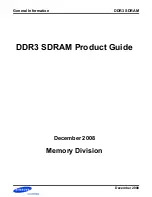
CP302
CMOS Setup
ID 21112, Rev. 05
Page 4 - 10
®
PEP Modular Computers GmbH
The BIOS has the capability to automatically detect the specifications and optimal
operating mode of almost all EIDE hard drives. When you select type
AUTO
for a hard
drive, the BIOS detects its specifications during POST, every time the system boots.
If you do not want to select drive type
AUTO
, other methods of selecting the drive type
are available as follows:
1.
Match the specifications of your installed EIDE hard drive(s) with the pre-
programmed values for drive types 1 through 45.
2.
Select
USER
and enter values into each drive parameter field.
3.
Use the EIDE
HDD
AUTO
DECTECTION
function in “Setup”.
The following table provides a brief explanation of drive specifications:
Table 4-2: Description of Drive Specifications
Spec.
Description
Type
The BIOS contains a table of pre-defined drive types. Each defined
drive type has a specified number of cylinders, number of heads, write
pre-compensation factor, landing zone, and number of sectors. Drives
whose specifications do not accommodate any pre-defined type are
classified as type
USER
.
Size
Disk drive capacity (approximate). Note that this size is usually slightly
greater than the size of a formatted disk given by a disk-checking
program.
Cyls.
Number of cylinders
Head
Number of heads
Precomp.
Write pre-compensation cylinder
Landz
Landing zone
Sector
Number of sectors
Mode
Auto
Auto: The BIOS automatically determines the optimal mode.
Normal
The maximum number of cylinders, heads, and sectors supported are
1024, 16, and 63 respectively.
Large
For drives that do not support LBA and have more than 1024 cylinders.
LBA
During drive accesses, the EIDE controller transforms the data address
described by sector, head, and cylinder number into a physical block
address, significantly improving data transfer rates. For drives with
greater than 1024 cylinders.
Artisan Technology Group - Quality Instrumentation ... Guaranteed | (888) 88-SOURCE | www.artisantg.com
















































